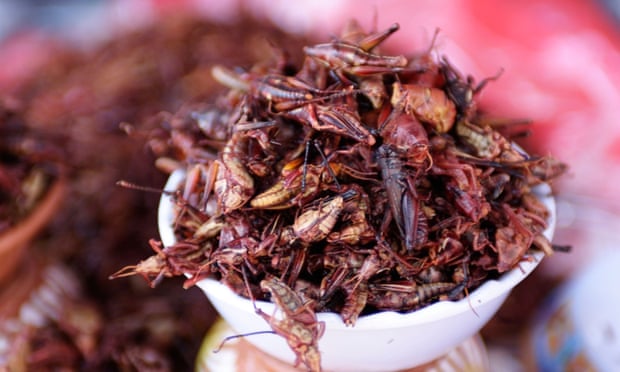
Eating insects has become common enough that the chains are experimenting with putting them on the menu, so it was only a matter of time before the wine matchers wanted in on the act. I’m at London’s Vinopolis where Beth Willard, buyer for wine merchants Laithwaite’s has chosen wines which she thinks will best complement the flavours of mealworms, grasshoppers, crickets and queen weaver ants. We’re trying cricket pad thai, Mexican grasshoppers on toast, a frangipane of pear, cinnamon and queen weaver ant, and that vermicular taco.
There’s nothing strange about eating insects. The UN’s Food and Agriculture Organisation (FAO) estimates that some 1,400 species are eaten as part of a staple diet across Africa, Asia and South America. There are four main groups: beetles; ants, bees and wasps; grasshoppers and crickets; and moths and butterflies. Add arachnids to that: tarantulas are popular in Cambodia – fried, they have the flavour of crab (unsurprisingly since they’re from the same family) and scorpions (again, with that fishy flavour) are big in China. In Thailand, crickets are served as bar snacks, the South Africans eat the caterpillar of the mopani moth, giant steamed water bugs are eaten all over south-east Asia, they eat termites in Ghana, the Japanese like silkworms. The list goes on.
Insects are reckoned to pack more protein per gram than fresh meat and some fish, they are rich in fat and important minerals, and farming them uses a fraction of the resources used in raising other livestock. As well as their nutritional value, the FAO says, there is “considerable potential for edible insects to provide income and jobs for rural people who capture, rear, process, transport and market the insects” and notes their variety, sold live, dried, smoked, roasted or in some other form.
Raising insects for food is an industry worth $20m in the US alone, and there are several companies in this country doing very nicely. “We sell to primary schools, outdoor activity centres, pubs, leisure parks such Alton Towers – and the clergy, who like to use locusts in their sermons on John the Baptist,” Nick Cooper, owner of Crunchy Critters, which provided today’s bugs, says. Halloween’s big for them, as is the annual new series of I’m a Celebrity … indicating a market that is more interested in highjinks than thinking of insects as a serious alternative food source. Cooper says his demographic is young men between 25 and 30, living in the south east of England. Oxfordshire is his biggest market, for reasons he can’t fathom.
There are so many good reasons to eat insects, and there’s no reason why I should be squeamish. I’ve been eating snails and molluscs since I was in short trousers, I love frogs’ legs, devour cheeses of miasmal pungency. I’m not put off by exoskeletons, I’ve eaten guinea pig, sea slug and cold calves’ brains. Why should I balk at a cricket? I think somewhere, I still associate insects with decay. But counter-intuitively on the point of freshness, that presents another hurdle. I have a disconcerting squishiness. I swear I just saw one move.
http://www.theguardian.com/lifeandstyle/picture/2013/sep/13/eating-insects-infographic-flies-entomophagy
Anyway, enough. In they go. Once I’ve got a mouthful of crickets, the taste is pleasantly mild and nutty, although the wings get caught in my teeth. But the overall experience could at best be characterised as disagreeable. why should a beetle larva cause me such distress? I think, in the end, it’s texture. I’ll just never get used to the powdery crunch of those cricket wings.
Cricket pad thai
The Pad Thai was made with rice noodles, bean sprouts, sautéed peanuts, spring onions and lime. The crickets themselves, half an inch long and readily identifiable, have a brittle crunch leading to chewiness as you bite through the body. Delicate flavour of hazelnuts with a hint of seafood. The cricket disintegrates in your mouth and leaves you exploring every cavity for remnants of wing and thorax. You need a very light, aromatic wine: the best match was the fragrant Cabrito Albillo 2012 from Madrid.
Mealworm tacos
Beetle larva, fried or roasted, is a best-seller for Crunchy Critters. Challenging to look at but the smell is pleasantly like root vegetables just pulled from the ground. Once on the tongue the flavour is unexceptional, slightly musty and earthy – it reminds me of parsnip crisps. The texture is hollow and friable, like a mouthful of dried scales. Comtesse de Bellefleur Grande Réserve Champagne worked well, its yeasty aromatics complementing the mustiness, but the best match again was the Albillo.
Chapulines (Mexican grasshoppers) on toast
For the first time I really feel the flavour. After the now-familiar exoskeletal chomp, an umami saltiness, a bit like miso, with notes of porcini mushrooms. The texture is far meatier than the crickets. There’s a salty aftertaste as well, and walnut-juice dryness. Exotic and foreign, the strong flavours overwhelm the aromatic whites but Gutierrez Colosia Fino NV with its concentrated nuttiness, and top notes of salted lime, is the perfect foil. Beth says she really feels like she’s eating salted tapas in the south of Spain.
Frangipane of pear, cinnamon and queen weaver ant
It looks like a mini pecan pie but the pecans are crushed ants, head, thorax and abdomen discernible. I haven’t seen an ant in such exploded detail since O Level biology. I’m afraid it just doesn’t work. It’s not sweet enough and between your teeth the ants release flavours of goat and sty, and a fine tang of faintly scented urine. Apparently ants are used mainly as a savoury topping and not a main ingredient, which makes sense. The champagne works really well again, mitigating the pungency, but the powerful flavours strip all the other wines of their fruit. Challenging, though the queen weaver is considered a delicacy.